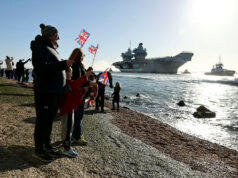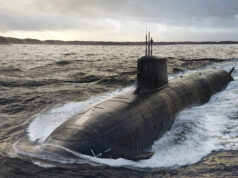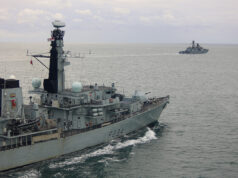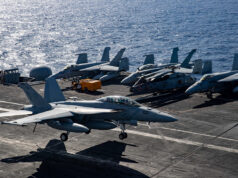An Arleigh Burke-class US Navy destroyer fired its 5-inch gun during live-fire gunnery training with allied ships in the Baltic Sea as part of NEPTUNE STRIKE 25-3, the UK Defence Journal understands.
The firing took place on 23 September when USS Bainbridge (DDG 96), operating with Carrier Strike Group 12, conducted a live gunnery serial alongside Finland’s Hamina-class missile boat FNS Tornio (81), Germany’s Sachsen-class frigate FGS Hamburg (F220), and Sweden’s Visby-class corvette Helsingborg (K32). Photographs released from the event show Bainbridge engaging a surface target with its Mk 45 5-inch gun during the exercise.
NEPTUNE STRIKE 25-3 is the third iteration of this large-scale enhanced vigilance activity, running from 22 to 26 September and spanning the Mediterranean, Adriatic, North and Baltic Seas.
Commanded by Naval Striking and Support Forces NATO, headquartered in Oeiras, Portugal, under US Vice Admiral Jeffrey T. Anderson, the event brings together more than 10,000 personnel from 13 allied nations to practise high-end maritime strike integration, deterrence and freedom of navigation operations.
The series, say the Alliance, is intended to test interoperability across air, land and sea, and to rehearse the protection of strategic maritime chokepoints. This iteration follows NEPTUNE STRIKE 25-2, which was held between 24 July and 1 August. During 25-3, Carrier Strike Group 12 is operating under NATO control alongside amphibious and surface elements to exercise combined maritime command and strike planning.
USS Bainbridge is a Flight IIA Arleigh Burke-class guided-missile destroyer, equipped with the Aegis combat system and a 5-inch/62 Mk 45 Mod 4 lightweight gun. The class carries a mix of anti-air, anti-surface and strike weapons, from ESSM and Standard family missiles to Tomahawk cruise missiles and ASROC anti-submarine rockets, together with organic MH-60R helicopter capability. The ship’s presence in the Baltic, and its live-fire activity with regional navies, demonstrates the integration of high-end US naval capability into multinational task groups.
Exercise participants used the opportunity to practise combined gunnery procedures, target designation and deconfliction in a congested maritime environment. The drills also provided a platform to rehearse command and control, information sharing and the coordination of multi-national strike effects.














That gun going off rocks yhe entire ship.
Seems unlikely since the broad side of a battleship doesn’t Rock the ship perceptually you do feel the thrum of the boom but it doesn’t Rock. The ship. Rocking the ship every time that gun fires would make it nearly impossible to calculate the next shot with any accuracy. Big guns like that are designed with various recoil limiting devices and to use a Star Trek term Inertial dampeners.
Star Trek reference is awesome!! 🤣
Former Aegis Firecontrolman here. The slight rocking of the gun is nothing compared to the sea-state induced motion. The guns are computer controlled. The first gun firecontrol computers around before ww1.